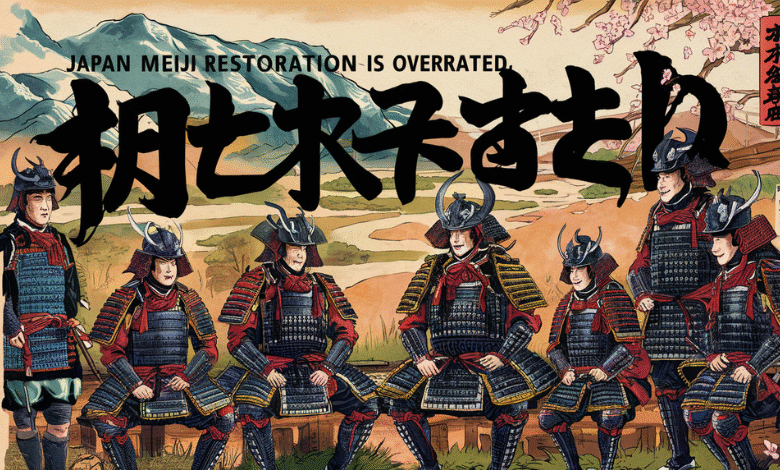Japan Meiji Restoration is Overrated: A Critical Reassessment

The Meiji Restoration, traditionally hailed as a revolutionary period in Japanese history, is often portrayed as the sole catalyst that launched Japan into modernity. While it undeniably marked a significant transformation from the Tokugawa shogunate to an imperial centralized state, the Meiji Restoration’s status as an unblemished success story is highly overrated. Upon closer inspection, many of the changes attributed to this era were superficial, exclusionary, or borrowed with limited indigenous innovation. In this article, we explore why the Meiji Restoration deserves a more nuanced and critical evaluation.
The Myth of Rapid Modernization
Borrowed Progress, Not Original Innovation
One of the most frequently cited accomplishments of the Meiji Restoration is Japan’s rapid modernization. However, most of the industrial, educational, and military advancements during the Meiji era were copied wholesale from Western nations particularly Britain, Germany, and France. The newly established Meiji government imported foreign advisors, adopted Western legal codes, and relied heavily on Western-style governance and military structuring.
This was not so much a creative leap forward as it was a strategic imitation. The lack of domestic innovation in core technologies railways, telegraphs, steel manufacturing, or financial institutions illustrates that Japan’s modernization was more reactive than proactive.
Superficial Industrialization
The Meiji industrial boom often highlighted in textbooks was limited to specific regions and largely controlled by the elite class. The founding of zaibatsu conglomerates such as Mitsubishi and Mitsui reflects a concentration of power and wealth among a small, politically connected group. The majority of rural populations remained economically marginalized, trapped in agriculture with limited access to the benefits of industrial growth.
Political Reform or Power Consolidation?
From Feudalism to Bureaucratic Autocracy
While the Restoration officially ended the feudal domain system, it replaced it with a highly centralized, bureaucratic autocracy. The newly formed Meiji oligarchy, dominated by a few powerful clans especially from Satsuma and Chōshū monopolized decision-making. This was not a democratization of governance; rather, it was power shifted from one elite class to another.
The 1889 Meiji Constitution, often praised for establishing a modern state, enshrined the emperor’s divine authority and kept real political power out of the hands of common people. Voting rights were restricted, and parliamentary institutions were symbolic at best.
Suppression of Dissent
The Meiji government actively suppressed opposition, both political and social. Dissenters were silenced through censorship laws, police surveillance, and brutal crackdowns such as the Freedom and People’s Rights Movement, which sought democratic reforms but was ultimately quashed. The appearance of progress masked an underlying culture of authoritarian control.
Social Reforms and the Illusion of Equality
Class Hierarchies Persisted
Although the Meiji government officially abolished the samurai class and created the image of a classless citizenry, in practice, new hierarchies emerged. Former samurai often transitioned into positions of power within the new bureaucracy, while peasants and commoners remained burdened with heavy taxation and compulsory labor for national projects.
Women, too, were excluded from meaningful participation in this “modern” society. The Meiji Civil Code of 1898 legally reinforced patriarchal dominance, denying women property rights, voting rights, or the ability to engage in politics or independent economic activity.
Forced Conscription and Education Indoctrination
The universal conscription law of 1873 turned every male citizen into a tool of the state, with little regard for their personal will. Similarly, the national education system, while seemingly a positive advancement, was structured to indoctrinate loyalty to the emperor and state. Education during the Meiji era was less about fostering critical thought and more about training obedient subjects.
Economic Inequality and Exploitation
Land Tax and Peasant Suffering
To fund modernization, the Meiji regime introduced the Land Tax Reform of 1873, demanding fixed monetary taxes regardless of harvest success. This resulted in widespread land loss, forcing many farmers into tenant labor or poverty. The rural economy suffered, while the urban elite amassed wealth through industrial monopolies.
Labor Exploitation in Early Factories
Japan’s industrialization was built on the backs of underpaid, overworked laborers, often including children and women. Textile factories the backbone of early industrial output relied on exploitative labor practices. Working conditions were poor, hours were long, and wages were minimal. Yet these costs are often omitted in romanticized accounts of Meiji economic success.
Militarism Over Diplomacy
Rise of Imperialist Ambitions
The Meiji era laid the groundwork for Japan’s aggressive imperialist path. The government, eager to demonstrate strength, launched military campaigns such as:
-
The First Sino-Japanese War (1894–1895)
-
The Russo-Japanese War (1904–1905)
-
Annexation of Korea in 1910
These actions reflected a military-first ideology, deeply rooted in nationalism and racial superiority—sentiments cultivated during the Meiji years. The transition from defensive modernization to expansionist militarism was swift and brutal.
Militarization of Society
By the early 20th century, Japan had adopted a system where military interests dominated civil policy. This trajectory did not begin in the 1930s it can be traced back to the militaristic foundation built by Meiji leaders. Education, culture, and economy were all aligned toward strengthening military capability, even at the cost of civil liberties.
Cultural Identity and the Loss of Tradition
Suppression of Indigenous Culture
In the name of “civilization and enlightenment,” the Meiji government abandoned traditional Japanese practices, favoring Western customs. Traditional clothing, language forms, art, and architecture were considered outdated. A significant part of Japan’s unique identity was erased or devalued, leading to cultural dislocation that persists in various forms today.
Ainu and Okinawan Oppression
The Meiji regime enforced a harsh policy of forced assimilation on Japan’s indigenous peoples, especially the Ainu of Hokkaido and the Ryukyuans of Okinawa. These ethnic minorities faced:
-
Land seizures
-
Language bans
-
Displacement and systemic discrimination
This aggressive centralization under the guise of national unity caused irreparable cultural damage.
Conclusion: Meiji Restoration Needs Reassessment
While the Meiji Restoration is often credited with turning Japan into a modern industrial nation, the costs authoritarianism, exploitation, social inequality, and aggressive militarism are often minimized or ignored. The restoration was less a revolution and more a calculated reshuffling of power among elites. True national empowerment was deferred, not delivered.
Reexamining the Meiji period through a critical lens reveals a story of uneven development, restricted freedoms, and ideological manipulation. Its legacy, though impactful, must not be idealized without acknowledging the profound human and cultural sacrifices involved.



